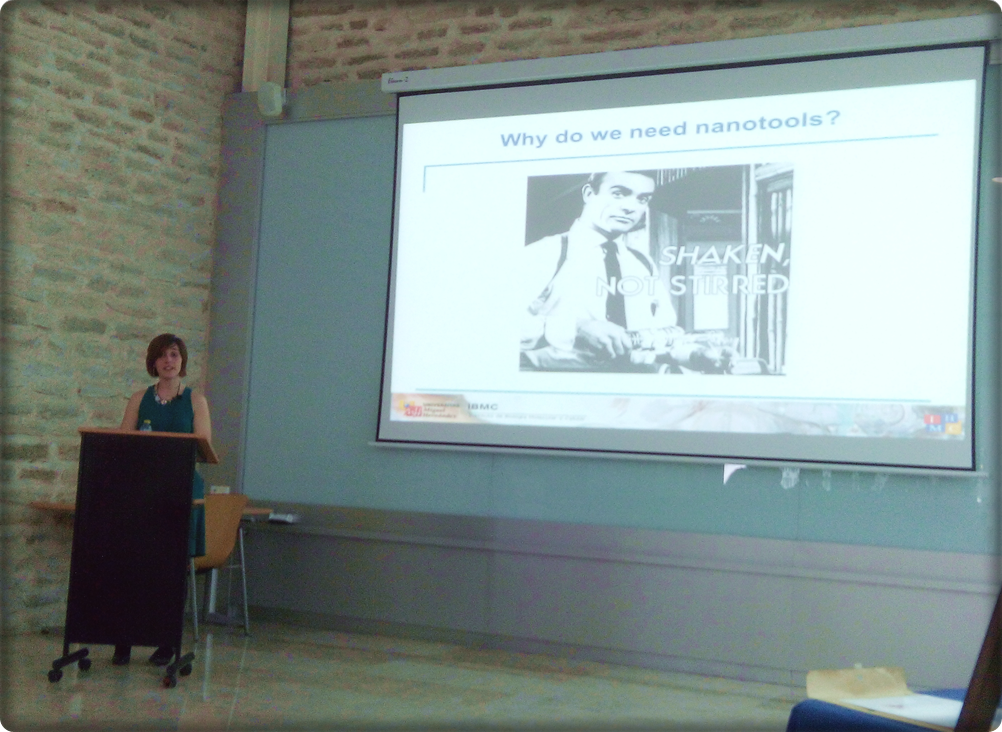Doctoral thesis Ainara López Córdoba
The general process of sensing involves the existence of specialised neurons called primary sensory neurons that innervate the whole body and collect all types of sensory data. Then, the conveyed information is translated into an electrical signal that is propagated to specific regions in the brain. Those primary sensory neurons on charge of the actual “sensing” are provided with specific receptors that selectively recognise different stimuli 3. Physical and chemical properties of these receptors determine the kind of stimuli the sensory neurons transduce . Thus, while olfactory sensory neurons are able to detect a myriad of volatile compounds, cones and rods are responsible of the sight sense and are sensitive to light, and receptors all around the skin sense changes in pressure and temperature to build the touch and temperature senses.
It is clear that sensing and interacting with the environment are essential for living organisms, and in this respect, the ability to sense potentially harmful stimuli becomes crucial as it can mean the difference between life and death. The process by which dangerous stimuli are detected and recognised is called nociception, and the primary sensory neurons responsible
for it are the nociceptors. The result of this process is the generation of pain, and it has a logical explanation: the outcome of the nociceptive process must be unpleasant enough to provoke in the organism a protective response to avoid the noxious stimuli that triggered it. Just as we are motivated to drink when we are thirsty, we are motivated to avoid behaviours that cause us pain.
Under normal situations, pain serves as a survival mechanism, in fact, the absence of pain is a dangerous disorder that can lead to death if adequate precautions are not taken. By contrast, under some pathological circumstances, pain loses its warning meaning and becomes an extremely unpleasant condition that dramatically disturbs people’s lives. Some examples of these pain disorders are diabetic neuropathy, fibromyalgia, migraine or irritable bowel syndrome. Unfortunately, and despite the fact that pain is a worldwide health problem, little advances have been reached for effective treatments of pain conditions, especially for persistent pain síndromes. This difficulty found in developing new effective drugs for treating chronic pain is partly due to an incomplete understanding of the biochemical and molecular mechanisms involved in pain signalling. Therefore, there is an urgent need of expanding the basic knowledge on the mechanisms underlying pain transduction.
Aiming for a complete understanding of nociception, a wide range of complementary approaches need to be integrated. From molecular methods where the actual receptors for noxious stimuli, the nocicensors, are the focus of the study, to systems biology, where understanding neuronal networks is of interest, different facets of the same phenomena have to be investigated. One possible strategy for pain relief consists on avoiding the pain signal to be generated at its very beginning, that is, at the level of pain receptors. Because some of the members of the family of Transient Receptor Potential channels (TRP channels) play important roles in noxious stimuli sensing and pain pathologies, these channels are promising targets for the development of new pharmacological and therapeutic tools. To identify regions of these proteins that could be targets for potential modulators it is essential to comprehend the molecular requirements for channel function. In this work, a molecular approach was firstly followed, studying the structure-function relationships of the N-terminal region of the TRP domain in TRP channels.
On the other hand, when the point of view widens from the single protein to the cellular level, in addition to nocisensors themselves, many new players enter the game: interactions with the cytoskeleton, phosphorylation and glycosylation levels, lipid composition of preferred locations, endogenous and exogenous molecules that alter their response, synthesis, transport or compartmentalization. The cellular picture emerging from studies of all these processes is that of a small, highly packed and extremely well organized system, where timing and location of the different components is the key to simultaneously carry out so many diverse tasks. In this respect, there is increasing evidence that point out the extreme importance of subcellular structures for the compartmentalization of cellular function: from the T- tubules of cardiomyocytes to the fine dendrites and axons of neurons. Therefore, as well as the structure-function relationships in the actual protein need to be studied, understanding the structure-function relationships of the sensory neurons as a whole is also essential.
One of the major challenges for investigating the complex cellular organization is to develop methods with nanoscale spatial resolution suitable for living cells. In addition, these methods need to be quantitative, have high spatial and temporal resolution and minimise disturbance to the cellular native environment. In this respect, nanoscale devices are the ideal candidates, and a large effort has been invested towards the design and implementation of new nanotechnologies. An effort as important as the recent American Brain Research through Advancing Innovative Neurotechnologies (BRAIN) project, or the European Brain Activity Map project, where funding of billions is budgeted for, among other objectives, the development of “nanotech tools for neuroscience”. In the present thesis this challenge was addressed by developing a nanodelivery system to locally stimulate nocisensors within the cell membrane, and a reactive oxygen species (ROS) nanosensor for intracellular measurements.

![[Facebook]](https://divulgacionibmc.umh.es/wp-content/plugins/bookmarkify/facebook.png)
![[LinkedIn]](https://divulgacionibmc.umh.es/wp-content/plugins/bookmarkify/linkedin.png)
![[Twitter]](https://divulgacionibmc.umh.es/wp-content/plugins/bookmarkify/twitter.png)

